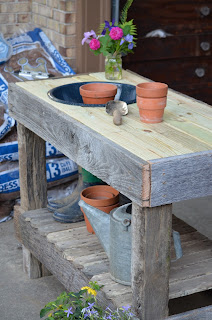To "come full circle" means "to complete a cycle of transition, returning to where one started after gaining experience or exploring other things:, according to Wiktionary.
The side entrance to my home, which serves as the main entrance to my home, has always been a prime spot for a container garden. Lots of display room, sunlight, and access to water. Early in my gardening career, I would fill five or six pots with a geranium, some petunias, a couple spikes, and call it done. By midsummer, the flowers and I were both tired - tired of watering, fertilizing, and deadheading.
I tried different combinations of flowers and foliage, with each year becoming more simplified. I had tired of the look and work of containers. Five or six pots, became only two, in time. The last several years have seen huge macho ferns take center stage, as they were a dependable specimen, easy to take care of, and provided a lot of bang for the gardening buck.
This year, however, the yearning for a bright, fussy garden outside my door took hold, after laying dormant inside my soul for years. I had to have lots of color, and lots of blooms greet me each time I opened the door. It had been a long difficult winter. Summer, warmth, and flowers seemed to be just the ticket to throw off the doldrums.
 Since I gave up on multiple containers full of blooms years ago, I also gave up on keeping lots of empty containers around. So, it was off to several garden centers in search of containers. This group sits to the left. Note the photobomb by Mama the cat.
Since I gave up on multiple containers full of blooms years ago, I also gave up on keeping lots of empty containers around. So, it was off to several garden centers in search of containers. This group sits to the left. Note the photobomb by Mama the cat.
And, here are the stars of the stage. Each and every color is represented. The range of color and texture available at garden centers is remarkable. This year, I particularly thrilled at the deep scarlet reds and oranges, from coral to peach to pumpkin.
There was no theme, no consistency, no plan. I bought what I liked. And, then, I became a little afraid. What if this madcap collection of color and texture looks terrible? What if orange, and pink, and yellow, and blue, and white and red and purple don't look good jumbled together?
Forging on, I began to plant the containers one cool day in late April. As you can see, I am not a neat gardener. Once I got started, I threw caution and just about everything else to the winds.
Here are the pots after planting, seemingly lost in their containers in late April.
By May 17, the plants had settled into their new homes, and had begun to fill out nicely.
This morning, June 7, the pots are almost overflowing their pots. They are bright, exuberant
and thriving.
Pinks and oranges share the same pot, and sit comfortably next to one filled yellow and blues. My favorite combination is the primary color pot featuring red, 2 yellows and a blue which sidles up to a white and purple combination. Huge zinnias and snapdragons are just about ready to bloom, and who knows what colors they will bring?
Closeups of some of my favorites, as they gleamed in the early morning sunshine.
My "walk on the wild side" this year has already given me more joy than I could have hoped. One cannot help but smile at the carnival outside my door. I am glad to have "come full circle".






































